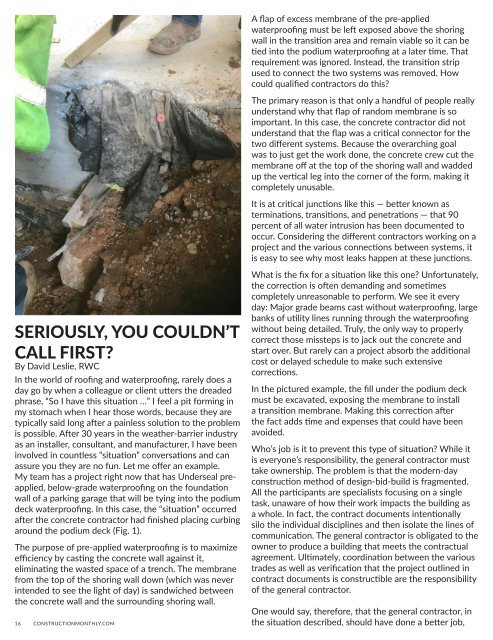Construction Monthly Magazine | Atlanta 2021 Build Expo Show Edition
You also want an ePaper? Increase the reach of your titles
YUMPU automatically turns print PDFs into web optimized ePapers that Google loves.
A flap of excess membrane of the pre-applied<br />
waterproofing must be left exposed above the shoring<br />
wall in the transition area and remain viable so it can be<br />
tied into the podium waterproofing at a later time. That<br />
requirement was ignored. Instead, the transition strip<br />
used to connect the two systems was removed. How<br />
could qualified contractors do this?<br />
The primary reason is that only a handful of people really<br />
understand why that flap of random membrane is so<br />
important. In this case, the concrete contractor did not<br />
understand that the flap was a critical connector for the<br />
two different systems. Because the overarching goal<br />
was to just get the work done, the concrete crew cut the<br />
membrane off at the top of the shoring wall and wadded<br />
up the vertical leg into the corner of the form, making it<br />
completely unusable.<br />
It is at critical junctions like this — better known as<br />
terminations, transitions, and penetrations — that 90<br />
percent of all water intrusion has been documented to<br />
occur. Considering the different contractors working on a<br />
project and the various connections between systems, it<br />
is easy to see why most leaks happen at these junctions.<br />
SERIOUSLY, YOU COULDN’T<br />
CALL FIRST?<br />
By David Leslie, RWC<br />
In the world of roofing and waterproofing, rarely does a<br />
day go by when a colleague or client utters the dreaded<br />
phrase, “So I have this situation …” I feel a pit forming in<br />
my stomach when I hear those words, because they are<br />
typically said long after a painless solution to the problem<br />
is possible. After 30 years in the weather-barrier industry<br />
as an installer, consultant, and manufacturer, I have been<br />
involved in countless “situation” conversations and can<br />
assure you they are no fun. Let me offer an example.<br />
My team has a project right now that has Underseal preapplied,<br />
below-grade waterproofing on the foundation<br />
wall of a parking garage that will be tying into the podium<br />
deck waterproofing. In this case, the “situation” occurred<br />
after the concrete contractor had finished placing curbing<br />
around the podium deck (Fig. 1).<br />
The purpose of pre-applied waterproofing is to maximize<br />
efficiency by casting the concrete wall against it,<br />
eliminating the wasted space of a trench. The membrane<br />
from the top of the shoring wall down (which was never<br />
intended to see the light of day) is sandwiched between<br />
the concrete wall and the surrounding shoring wall.<br />
16 CONSTRUCTIONMONTHLY.COM<br />
What is the fix for a situation like this one? Unfortunately,<br />
the correction is often demanding and sometimes<br />
completely unreasonable to perform. We see it every<br />
day: Major grade beams cast without waterproofing, large<br />
banks of utility lines running through the waterproofing<br />
without being detailed. Truly, the only way to properly<br />
correct those missteps is to jack out the concrete and<br />
start over. But rarely can a project absorb the additional<br />
cost or delayed schedule to make such extensive<br />
corrections.<br />
In the pictured example, the fill under the podium deck<br />
must be excavated, exposing the membrane to install<br />
a transition membrane. Making this correction after<br />
the fact adds time and expenses that could have been<br />
avoided.<br />
Who’s job is it to prevent this type of situation? While it<br />
is everyone’s responsibility, the general contractor must<br />
take ownership. The problem is that the modern-day<br />
construction method of design-bid-build is fragmented.<br />
All the participants are specialists focusing on a single<br />
task, unaware of how their work impacts the building as<br />
a whole. In fact, the contract documents intentionally<br />
silo the individual disciplines and then isolate the lines of<br />
communication. The general contractor is obligated to the<br />
owner to produce a building that meets the contractual<br />
agreement. Ultimately, coordination between the various<br />
trades as well as verification that the project outlined in<br />
contract documents is constructible are the responsibility<br />
of the general contractor.<br />
One would say, therefore, that the general contractor, in<br />
the situation described, should have done a better job,

















